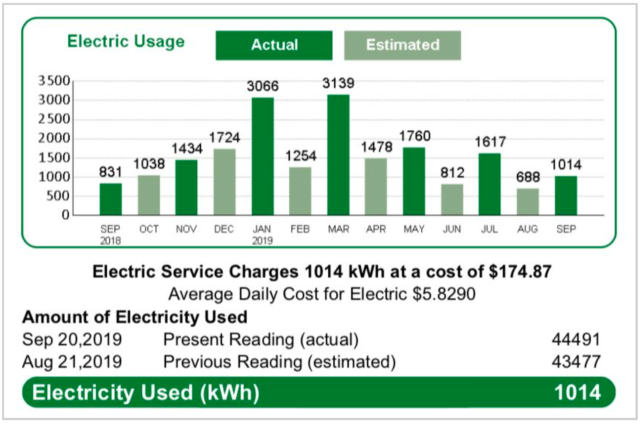A Guide to Your Central Hudson Bill with Solar
You’ve gone solar! Here’s how to interpret your Central Hudson bill with solar…
Solar credit will appear on the first and third pages of your bill.
On page 1 you’ll see a complete Bill Summary. Your solar credits will be included in the “Billing Adjustments” line item, however, this line could include more than just solar credits if there were additional adjustments to your bill. To see the exact amount of solar credit applied to your bill in a given bill cycle, please see “Community Distrib Generation Credit” at the bottom of page 3.
Page 1 – Bill Summary
Page 3 – Payments and Adjustments
Solar production varies month-to-month.
Solar credits are determined by how much solar is being produced in real time, so they’ll fluctuate with the seasons. In the summer, when the days are long, and sunlight is more direct, the CSA is producing a lot more electricity than in the winter when the days are shorter and darker.
Banked Solar Credit
In months when your solar production outpaces your electricity usages, you’ll have a surplus of solar credits that will rollover and be applied to next month’s bill. Please note: you won’t see banked credits on your bill, but rest assured, Central Hudson is keeping track. If you would like to see how many credits you have banked, contact our Customer Support team.
Your SunCommon CSA subscription is determined based on your historical annual electricity usage. Using that information we’re able to estimate the cost of your yearly Central Hudson bill. Then, that number is plugged into the value stack calculator to estimate the value of your solar credits (and your SunCommon payment). Since this amount was calculated based on a year’s worth of electricity, we divide by 12 and voila, we have your monthly SunCommon payment! Calculating the value of solar credits in this way allows you to have a predictable SunCommon payment each month.
Frequently Asked Questions
Any kWh electricity supply and delivery charges can be covered by CDG credits, including the Basic Service Charge.
On page 3 of your bill, look for the line item “Electricity Used (kWh)”:

Your billing cycle will not change. Members of the same community solar array (CSA) bill at different times throughout the month based on Central Hudson’s meter read routes by location. Because of this, your usage period and the solar generation period will not perfectly align and solar credit displayed on your bill may be the previous month’s solar generation.
There’s a bit of a delay. Central Hudson will show the solar credits produced by your portion of the array 60-90 days after the project is turned on, or 60-90 days after you become a member of the CSA.
The credits generated from any Community Solar Array in New York will show up as a dollar credit on your utility bill. The value of that credit (or solar electricity produced) varies day-to-day and month-to-month depending on market variables, just like oil or gas.
For the Red Hook and Pointe of Praise CSAs, Central Hudson determines the value of the credit using the Value Stack Method. Over a year, the total value of your solar credits should be similar to what you are paying SunCommon over the same time.
Even if you receive your electric supply from an energy supply company (ESCO), the solar generation will always be valued based on the value stack rates. You can view your ESCO’s supply rate on page 3 of your bill. If in a given month, Central Hudson’s supply rate is below your ESCO’s rate, you will need more solar credit to offset your supply charges. You can view Central Hudson’s current supply charges on their website.
You are eligible to remain on budget billing. When you start receiving credits from the CSA you will continue to be billed the same budget billing amount. As usage/generation credit history is built, the budget will be adjusted accordingly at the end of a budget period.
Utility companies can change how this information appears, so if your bill doesn’t look like the examples, don’t worry. Give us a call and we’ll help you figure it out.
What is a CCA?
CCA stands for Community Choice Aggregation. It’s a way for your local elected officials to choose a third party company to supply your electricity instead of the utility. Your utility will continue to deliver your electricity. Most CCAs strive for some savings with renewable energy.
Can I have a Community Solar membership and participate in the CCA?
Yes, you can have both. The CCA may lower your overall monthly bill a little, by lowering the “supply” part of your bill. The CSA credits will appear as a separate line item on your bill, and will help offset the sum of the basic service charge, delivery charges, and CCA supply charges on your bill.
How is a CCA different from a SunCommon CSA?
By participating in a SunCommon CSA, you are choosing to purchase your electricity from a specific local solar project. The local solar array will produce electricity and feed it directly into the utility grid so you can benefit from monthly credits reducing your electric bill. CCAs are managed by a third party administrator that work with several different Energy Service Companies and Distributed Energy Resource providers to aggregate a mix of renewable energy sources.
What’s our take?
SunCommon works alongside CCAs because they help support renewable energy sources, even if they are far away from your home. CCAs also help provide more local choice and control over energy sourcing and production. SunCommon installs local residential, commercial, and community solar systems to help you create clean energy right where it is used. We believe that everyone has the right to a healthy environment and brighter future—and renewable energy is where it starts.
